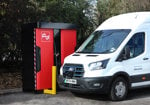But the Mini's popularity did gradually wane as it eventually succumbed to changes in fashion and expectations.
With the development of modern technology and higher specification levels on every other car the Mini got left behind. Even formerly loyal fans found other cars that suited their purposes better.
Then the all-new MINI from BMW came along and suddenly all the traditionalists, most of whom had abandoned the old Mini years previously, jumped up and down and said it wasn't a Mini. And let's face it, they were right.
The new MINI is light years ahead of the old one and behind the wheel it's like the difference between a Tiger Moth and a Tornado. But they do have more in common in today's used market.
After years in the wilderness, the old classic Mini has regained credibility. It's fashionable again, despite the absence of all those modern car luxuries everyone has become accustomed to.
So is this revival due to the new MINI? Is it the case that some of those who aspire to the new one, but can't afford it, are going for the classic as an alternative? Or is it a case of the new MINI simply reminding people who want small urban transport that it can be had cheaply from the old model? Or is it just an attack of nostalgia? I don't have the answer because I really can't think of a good reason to buy one.
But it does set a standard for new MINI in terms of longevity. How will today's version fare in 40 years?
Plate change is a mystery
I SPOKE to many new car dealers towards the end of September and just about all of them were struggling to meet their new car targets, from the lower end of the market up to the prestige brands.
This is nothing new, but there have been many well-documented reasons for this year's lack of registrations. June was a non-starter thanks to the Jubilee and World Cup so some sales were dragged from July into June to ensure targets were met for the second quarter. But the hope that lost business in June would be regained over the coming months was a false one and culminated in a difficult third quarter for most.
Some say that targets were too high for August and September. In fact some manufacturers set them much higher than March despite the fact that March is proving to be the big one, and will continue to be so.
The public is not inspired by a new plate in September – after all, who is going to wait until early autumn to buy a new car?
Next year's 03 plate will do very well while the 53 will, like this year's 52 plate, will get little attention.
Maybe the industry should do more to market the September change and not just leave it to chance. Some dealers will have had to put on extra demonstrators and change courtesy cars and this in turn leaves the used car forecourt full of nearly-new cars, in direct competition with the new ones in the showroom. Then we're straight into the battle for the next quarter. Why we need a twice-yearly plate change remains a mystery, but that's another story.'















Login to comment
Comments
No comments have been made yet.